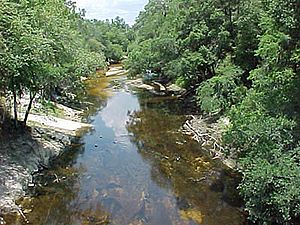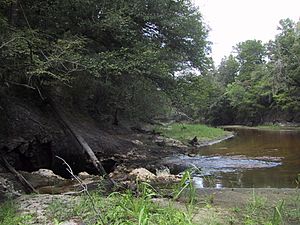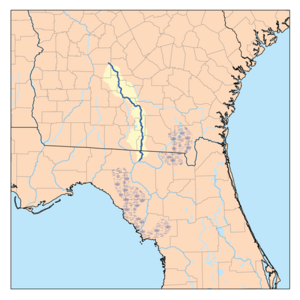Alapaha River facts for kids

The Alapaha River is a river that flows for about 202 miles (325 km) through southern Georgia and northern Florida in the United States. It's like a smaller stream that feeds into a bigger one, called the Suwannee River, which eventually flows into the Gulf of Mexico.
Contents
River History
Long ago, when the explorer Hernando de Soto traveled through this area, his team wrote about a village called "Yupaha." People think this village might have been near the Alapaha River because the names sound similar. Another old record mentions a village called "Atapaha," which also sounds a lot like Alapaha. It's believed this town was on the river too.
Later, in the 1840s, a German writer named Friedrich Gerstäcker wrote an adventure story called Alapaha, or the Renegades of the Border. He named a brave Cherokee woman in his story "Alapaha." This book became quite popular!
During the American Civil War, the swampy areas along the Alapaha River became a hiding place. Some groups of soldiers who left the Confederate army used these swamps to stay safe.
River's Journey
The Alapaha River starts in southeastern Dooly County, Georgia. It then flows mostly southeast through or along the edges of many counties in Georgia, including Crisp, Wilcox, Turner, Ben Hill, Irwin, Tift, Berrien, Atkinson, Lanier, Lowndes, and Echols Counties.
After that, it enters Hamilton County in Florida. Finally, it joins the Suwannee River about 10 miles (16 km) southwest of Jasper. Along its way, the river passes through several Georgia towns like Rebecca, Alapaha, Willacoochee, Lakeland, and Statenville.
The Alapaha River also collects water from other smaller rivers. Near Willacoochee, Georgia, it meets the Willacoochee River. In Florida, it's joined by the Alapahoochee River and the short Little Alapaha River.
The River That Disappears
The Alapaha River is special because it's an intermittent river for part of its journey. This means that sometimes, when there isn't much rain, parts of the river actually disappear underground! It becomes a subterranean river, flowing beneath the surface.
About 2.3 miles (3.7 km) downstream from Jennings, Florida, a usually dry riverbed called the Dead River joins the Alapaha. This area has several sinkholes, including the Dead River Sink. When the water level is low, the Alapaha River can even flow *backwards* into the Dead River and vanish into these sinkholes.
A few miles further downstream, there's another large sinkhole. It's known by a few names, like the Alapaha River Sink, Suck Hole, or the Devil's Den. During dry times, the Alapaha River completely disappears into this sinkhole. This leaves a long stretch of its riverbed dry.

But don't worry, the river doesn't stay gone forever! The Alapaha River reappears at a place called the Alapaha Rise, which is about half a mile upstream from where it finally meets the Suwannee River. During very dry periods, more than 11 miles (18 km) of the riverbed can be completely dry because the water is flowing underground.
Other Names for the River
Over time, the Alapaha River has been known by many different names. In 1891, the United States Board on Geographic Names officially decided its name would be "Alapaha River." Some of the other names it was called include Alabaha River, Alapa Haw River, Allapaha River, and Lop Haw River.
Images for kids







